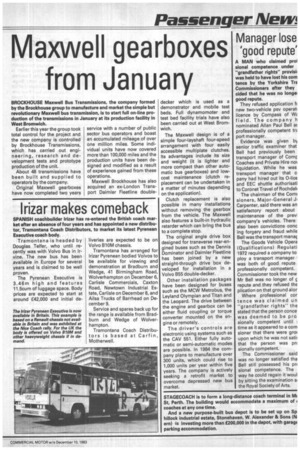Maxwell gearboxes from January
Page 23

If you've noticed an error in this article please click here to report it so we can fix it.
BROCKHOUSE Maxwell Bus Transmissions, the company formed by the Brockhouse group to manufacture and market the simple but revolutionary Maxwell bus transmission, is to start full on-line production of the transmissions in January at its production facility in West Bromwich.
Earlier this year the group took total control for the project and the new company is controlled by Brockhouse Transmissions, which has carried out engineering, research and development tests and prototype production of the unit.
About 48 transmissions have been built and supplied to operators by the company.
Original Maxwell gearboxes have now completed two years service with a number of public sector bus operators and boast an accumulated mileage of over one million miles. Some individual units have now covered more than 100,000 miles and the production units have been designed and modified as a result of experience gained from these operations.
Maxwell Brockhouse has also acquired an ex-London Transport Daimler Fleetline double decker which is used as a demonstrator and mobile test beds. Full dynamomoter and test bed facility trials have also been carried out at West Bromwich.
The Maxwell design is of a simple four-layshaft four-speed arrangement with four easily accessible multiplate clutches. Its advantages include its size and weight (it is lighter and more compact than other automatic bus gearboxes) and lowcost maintenance (clutch replacement can be undertaken in a matter of minutes depending on the application).
Clutch replacement is also possible in many installations without removing the gearbox from the vehicle. The Maxwell also features a built-in hydraulic retarder which can bring the bus to a complete stop.
The original angle drive box designed for transverse rear-engined buses such as the Dennis Dominator and Daimler Fleetline has been joined by a new straight-through drive box developed for installation in a Volvo B55 double-decker.
Other installation packages have been designed for buses such as the MCW Metrobus, the Leyland Olympian and Titan and the Leopard. The drive between the engine and gearbox can be either fluid coupling or torque converter mounted on the engine or remotely.
The driver's controls are electronic using systems such as the CAV 551. Either fully automatic or semi-automatic modes are possible. In 1984 the company plans to manufacture over 300 units, which could rise to 1,000 units per year within five years. The company is actively seeking a retrofit market to overcome depressed new bus market.












































































































